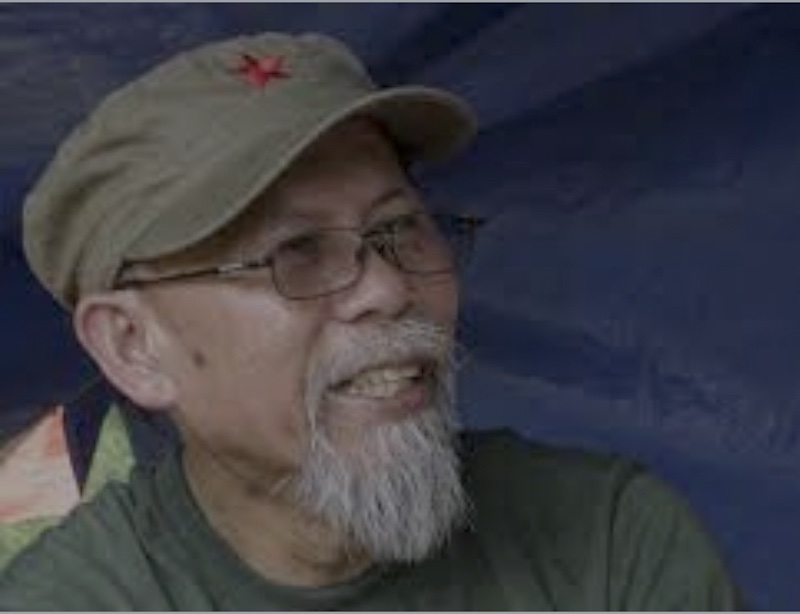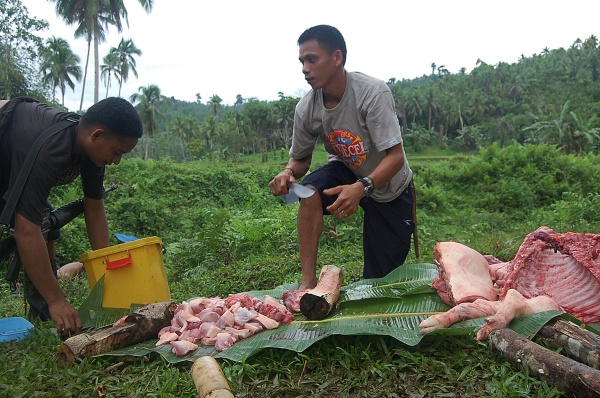1st of three parts
SAN AGUSTIN, Surigao del Sur (MindaNews/06 January) — On the night martial law was announced in 1972, the campus of the Central Mindanao University in Musuan, Bukidnon teemed with student groups discussing what options they would take now that the rumored declaration of martial law had come true.
Jorge Madlos, then a fifth year Agri-Engineering student, recalls that about a hundred chose to go to the hills.
Now 62, Madlos is among a handful who has stayed on despite a three-year incarceration in Camp Crame (1989 to 1991), despite the fact that since 1987, he has been suffering from a debilitating illness.
 Jorge Madlos aka Ka Oris, spokesperson of the National Democratic Front in Mindanao. MindaNews photo by Gregorio Bueno
Jorge Madlos aka Ka Oris, spokesperson of the National Democratic Front in Mindanao. MindaNews photo by Gregorio Bueno
Madlos has stayed on because “this is where I’m happy.” In a 1996 interview, he told this reporter he stayed on because “here I can contextualize the problem and really feel the pulse of the masses.”
During the ceasefire in 1986, Madlos went home to Siargao in Surigao del Norte to a father who, not having seen him for about 14 years, hardly recognized him.
“You must be proud all your children have finished college,” he told his father. “No. Not all. You haven’t,” his father said.
The years of living as a guerrilla of the New People’s Army (NPA) has taught him valuable lessons.

Madlos has spent more than 40 years of his life as a revolutionary, 17 years of that as spokesperson of the National Democratic Front (NDF) in Mindanao. A reporter who joined nearly a hundred others in covering the 42nd anniversary of the Communist Party of the Philippines (CPP) in San Agustin, Surigao del Sur on December 26, 2010, described him as one of five pre-martial law activists who has remained active in the underground movement.
Madlos says he’s one of “around 10.”
He reacts to a story naming him the “new face” of the CPP. “I am spokesperson of NDF Mindanao. He explains that while the revolutionary movement has decentralized its representation in public through party spokespersons, regional spokespersons, most of the spokespersons are from the NDF.
Mindanao, he says, is the only island-grouping with a spokesperson because it is only in Mindanao, he said, where there is an “island-wide momentum in the NDF. There is no Luzon-wide NDF or Visayas-wide NDF, he said.
It’s historical, he explains. “In the past, the NDF was regionalized but it was only in Mindanao where it was island-wide. It wasn’t designed that way but that’s how it evolved.”
MindaNews’ Carolyn O. Arguillas met with Madlos in San Agustin, Surigao del Sur on December 29, there days after the 42nd anniversary of the CPP, just as they were preparing to vacate the area before the end of the 19-day ceasefire on January 3.
Excerpts from that interview:
Q: Why are you still around?
A: It’s where I’m happy.
Q: You’ve seen it all — from pre-martial law to martial law, having joined the NPA, as spokesperson of NDF Mindanao, etc. You’ve spent decades out here. You’ve seen people come and go, revolutionaries dying or dead, retired, tired, but Jorge Madlos is still around?
A: Anybody who is not imprisoned or dead, I think most of us have embodied the spirit to continue to go on. We’ve found our place. We are no longer looking for another role in our life. So this is it. This is where we belong. I mean this is where we can better contribute and
Q: This is where you’re going to die also?
A: Yeah. Of course. We understand what life is. We are fulfilled in our lives, most of the revolutionaries, except those who waver because of personal problems, most of us are happy as revolutionaries.
Q: Where are your children now?
A: Wa man koy nakumbinsi na mosama sa ako (I wasn’t able to convince them to join us). They have their own lives, they are mature enough to choose how they will…
Q: You have grandchildren?
A: None yet. The youngest has finished her nursing course and is now a nurse in the US.
Q: Wow ha. The revolutionary’s daughter is in the land of the imperialists.
A: American dream.
Q: The boy?
A: He’s in Cebu working in a call center. Lain-lain gyud ang direction (Their directions are different).
Q: Do they ever experience harassment
A: The girl when she was young was kidnapped by (military) intelligence but she was returned.
Q: And your wife
A: Is in the movement. She’s not here now.
Q: I’ve documented, I’ve seen revolutionaries come and go also but you’re consistent. You’re still around.
A: I’m the only one exposed to media. The rest you cannot trace. They are just hiding around. I think there are others who are even more consistent than I am but are not known to the media.
Q: Your children understand why their parents
A: Of course. Proud sila sa ako (they’re proud of me). The only thing is that they cannot take our shoes. Di nila kaya (they can’t).
Q: Does that bother you?
A: No. Everybody is exposed to whatever kind of society there is. That is their exposure. Their cravings are different from ours. It’s not because they are not good sons and daughters, they’re okay as son and daughter, but it just happens that their orientation belongs to where they are so we do not blame them. Otherwise, we will be blaming all the youth. We love them as they are even if they don’t embrace the movement. That is also respect for people, respect for our family. We are proud of them in spite of the fact that our life directions are different. But I can say in public that I am proud of them.
Q: Okay, you’ve seen revolutionaries come and go you’ve seen so many deaths also
A: Like my.. very close friends, the comrades
Q: The issues in the 1970s were very clear. We lived in a dictatorship, the military was oppressive, abusive etc ., It’s now 2010, what are the issues that would still drive the young ones into joining the revolutionary movement?
A: Basically nothing has changed. We have different means and different leaders in the land but basically nothing has changed, you still have people without land. In fact, it’s worse now because the monopoly over land has now been cornered by multinational corporations. The situation is worse now than under martial law. It’s just that martial law is not sort of democracy over the people pero kung tan-awon nimo, ang kinabuhi mas arang-arang pa tong panahon sa martial law (if you look at it, life was relatively better during martial law), it’s just that there is now a semblance of (democracy) but in reality there is no such thing as a democracy. Democracy is for whom? Democracy for the upper class? So it’s the same aspiration as 30 to 40 years ago when martial law was declared.
Q: When you were young…
A: When I felt it was just a fad, I thought that it was just a fad, and all the things that I heard about imperialism, bureaucrat capitalism, feudalism, the need for the revolution, the Communist Party of the Philippines. All these things seemed in my youth passing things and it just happened when martial law was declared, I decided to go underground after three or four years. I decided to go up, to join the NPA. Even if I was already with the NPA then, I thought it was a passing moment for the youth.
Q: You’re saying basically nothing has changed?
A: It is worsening although there is a semblance of democracy. We’ve taken away the direct dictatorship but it’s the same.
(Tomorrow: “We were wrong in our political line”)
